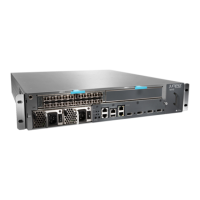Memory utilization 12 percent
CPU utilization:
User 0 percent
Background 0 percent
Kernel 1 percent
Interrupt 0 percent
Idle 97 percent
Model RE-3.0
Serial ID P10865701255
Start time 2005-02-03 03:13:39 UTC
Uptime 13 days, 21 hours, 12 minutes, 35 seconds
Load averages: 1 minute 5 minute 15 minute
0.00 0.03 0.01
The HCM in the slot labeled HCM0 is paired with the Routing Engine in the slot labeled
RE0. Likewise, the HCM in the slot labeled HCM1 is paired with the Routing Engine in the
slot labeled RE1. By default, the HCM in the slot labeled HCM0 is the master. However,
in this instance, the Routing Engine in slot RE1 has taken over mastership, indicating that
the HCM in slot HCM1 is also master.
Perform A Swap Test
NOTE: Although steps to remove and install an HCM are provided here, ensure
that you refer to the appropriate hardware guide for the latest information.
Before performing a swap test, always check for bent pins in the midplane
and check the HCM for stuck pins in the connector. Pins stuck in the
component connector can damage other good slots during a swap test.
The HCM is hot-pluggable. You can perform a swap test on an HCM to pinpoint the
problem.
1.
Remove an HCM on page 538
2.
Install an HCM on page 540
Remove an HCM
The HCM is hot-pluggable. You can perform a swap test on an HCM to try to pinpoint
the problem
To remove an HCM:
1. Place an electrostatic bag or antistatic mat on a flat, stable surface.
2. If a Routing Engine is installed in the same row as the HCM you are removing, remove
the Routing Engine first. If two Routing Engines are installed, use one of the following
two methods to determine which HCM is functioning as master:
•
Note which of the blue MASTER LEDs is lit on the Routing Engine faceplates.
•
Use the following command:
user@host> show chassis environment hcm
Copyright © 2012, Juniper Networks, Inc.538
M Series and T Series Routers Monitoring and Troubleshooting Guide

